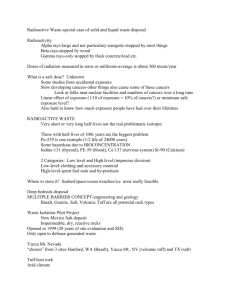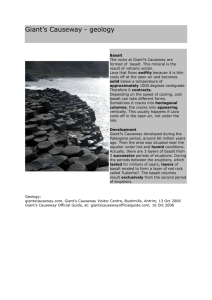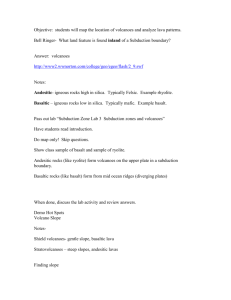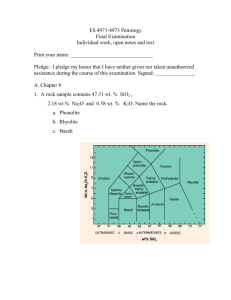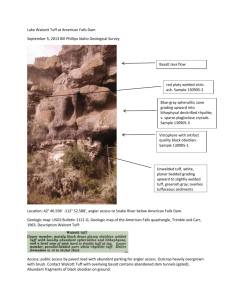GW_Rpt_41_Appendix_07_stratigraphic_units
advertisement
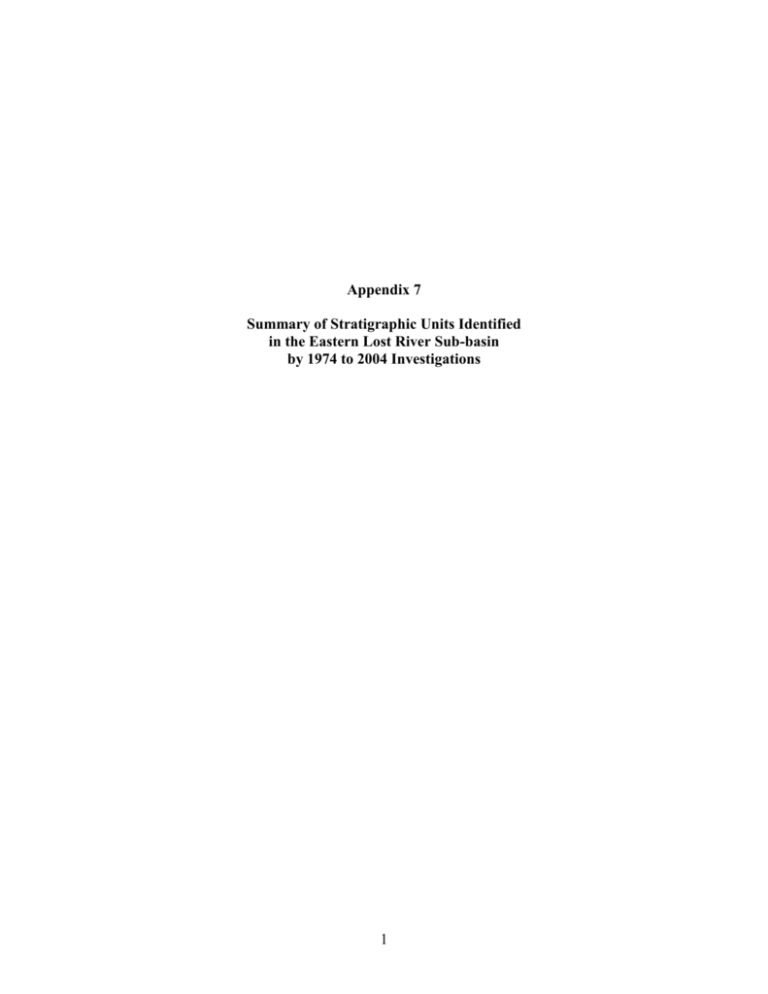
Appendix 7 Summary of Stratigraphic Units Identified in the Eastern Lost River Sub-basin by 1974 to 2004 Investigations 1 Eastern Lost River Sub-basin Portion of Ground Water in Selected Areas in the Klamath Basin, Oregon (from Leonard and Harris, 1974) Quaternary Deposits Qal Alluvium (Holocene and Pleistocene) Silt, sand, clay, peat, volcanic ash, pumice, gravel, and slope debris near escarpments Generally occurs in lowland areas, thin to several hundred feet thick Qb Basalt flows (Holocene and Pleistocene) Widespread thin flows of gray, vesicular basalt in units 20 to 30 feet thick Forms rimrock and cap lower slopes around major valleys QTb Basalt, breccia, and pyroclastic rocks (Pleistocene and Pliocene) Thick sequence of basaltic flows, breccia, and pyroclastic rocks forming upland masses Can locally interfinger with lacustrine beds of Yonna Formation Can include flows of other basalt units QTve Rocks of volcanic eruptive centers (Pleistocene and Pliocene) Eruptive and shallow intrusive rocks of main eruptive centers Includes basaltic, andesitic, and light colored rocks such as rhyolite and dacite Main mass and lower slopes of some major mountains as well as small peaks or cones Tertiary Deposits Ty Yonna Formation (Pliocene) Stratified siltstone, diatomite, sandstone, pumice, gravel, and tuff Origin is largely lacustrine Can locally include welded tuff beds or interbedded thin lava flows Underlies lowlands and forms lower slopes around valleys Tbt Breccia and tuff of volcanic maars (Pliocene) Highly dipping resistant beds of tuff and volcanic breccia near volcanic vents Partly contemporaneous with Yonna Formation Tb Lower basalt unit (Pliocene) Basaltic flows, tuff, and breccia Underlies Yonna Formation, but exposed in small areas 2 Eastern Lost River Sub-basin Portion of the Klamath Falls 1° by 2° Quadrangle (from Sherrod and Pickthorn, 1992) Quaternary Deposits Qs Surficial deposits (Holocene and Pleistocene) Fine to coarse grained sediment deposited in channels, flood plains, marshes and lakes Qf Alluvial fan and talus deposits (Pleistocene) Poorly to well sorted sand and gravel in alluvial fans and talus on some fault escarpments Qls Landslide debris (Pleistocene) Unsorted chaotic deposits at the foot of step slopes and fault escarpments QTs Sedimentary deposits and rocks (Pleistocene and Pliocene) Unconsolidated sand and gravel, poorly to moderately indurated sandstone and conglomerate, and diatomite It includes strata that unconformably overlie continental sedimentary rocks (Miocene and Pliocene) Tertiary Deposits Tb1 Basalt of Basin and Range unit 1 (Pliocene) Aphyric to porphyritic lava flows and minor breccia; chiefly intergranular to subophitic and locally diktytaxitic basalt and lesser amount of intergranular basaltic andesite. Locally includes interbedded, poorly exposed, poorly indurated sedimentary and pyroclastic volcanic rocks Tb1 conformably and unconformably overlies Tb 2 K-Ar age date of 3.68 to 2.80 Ma Tb2 Basalt of Basin and Range unit 2 (Pliocene) Aphyric to porphyritic lava flows and minor breccia; chiefly intergranular to subophitic and locally diktytaxitic basalt and lesser amount of intergranular basaltic andesite Locally includes interbedded, poorly exposed, poorly indurated sedimentary and pyroclastic volcanic rocks Tb2 lithologically indistinquishable from Tb1, separated by geomorphology and structure K-Ar age date of 6.88 to 3.61 Ma Tb3 Basalt of Basin and Range unit 3 (Miocene) Aphyric to porphyritic lava flows and minor breccia; chiefly intergranular to subophitic and locally diktytaxitic basalt and lesser amount of intergranular basaltic andesite Locally includes interbedded, poorly exposed, poorly indurated sedimentary and pyroclastic volcanic rocks Flows show extensive alteration of groundmass glass to greenish smectite K-Ar age date of 5.78 ± 0.12 Ma Tv Vent deposits (Pliocene and Miocene) Cones and irregular piles of cinder, agglutinate, and minor lava flows and intrusions forming vents for basalt of Basin and Range Typt Younger palagonite tuff (Pliocene and Miocene) Poorly bedded deposits of palagonized basaltic ash and lapilli and minor interbedded laval flows. Commonly forms discrete circular tuff cones centered around individual vents. Interfingers with and overlies continental sedimentary rocks (Tcs). Partial equivalent with abandoned Yonna Formation 3 Tcs Continental sedimentary rocks (Pliocene and Miocene) Thinly bedded to very thick ashy diatomite; thin to medium bedded sandstone, siltstone, and laminated mudstone; conglomerate; and minor tuff and basalt lava flows Overlies tuff units Tt and interbedded with Tb3 Partial equivalent with abandoned Yonna Formation Tst Tuff and sandstone (Pliocene and Miocene) Pale to medium gray lithic tuff and weakly lithified tuffaceous sandstone, some of which probably deposited as lahars Probably interbedded with Tb2 Tba Basaltic andesite and andesite (Pliocene and Miocene) Aphyric to porphyritic, intergranular to pilotaxitic lava flows and minor breccia Tad Andesite and dacite (Pliocene and Miocene) Two-pyroxene andesite and hornblende bearing dacite lava flows and domes Tr Rhyolite and rhyodacite (Pliocene? And Miocene) Slightly to moderately porphyritic domes; vary from lithoidal to vitrophyric K-Ar age dates of 6.06 ± 0.09 to 5.15 ± 0.21 Ma Tt Tuff and lapilli tuff (Miocene) Lithic bearing and pumaceous lapilli tuff, largely of ash flowor hot avalanche origin; also includes thin to medium bedded fine grained tuff, coarse pumicite (air fall), and very thick to thinly bedded pebbly sandstone probably deposited as lahars Overlies Tb3 Previously included with abandoned Yonna Formation Topt Older palagonite tuff (Miocene) Poorly bedded deposits of palagonitized basaltic ash and lapilli Some vents for Tb3 and Tv; individual eruptive centers with large masses of palagonite K-Ar age of 5.52 ± 0.55 Ma 4 Bonanza Quadrangle Map (Hladky, 2003) Surficial Deposits Qal Qws Qaf Qc Qap Qs Alluvium (Holocene) Unconsolidated silt, sand, and minor gravel deposited along the Lost River Thickness generally 1-3 m (3-10 ft) Windblown sand (Holocene) Brown, well-sorted sand deposited in swales in upland areas Thickness generally less than 0.3 m (1 ft) Alluvial fan deposits (Holocene and Pleistocene) Poorly sorted, unconsolidated, sand, soil, gravel, and boulders Thickness usually a few meters, but as much as 20 m (60 ft) Colluvium (Holocene and Pleistocene) Unconsolidated to slightly consolidated, poorly sorted soil and fragments of bedrock Thickness usually a few meters, but as much as 20 m (60 ft) Playa deposits (Holocene and Pleistocene) Cream to white, fine silt, mud, and alkali salts Thickness variable, to about 10 m (30 ft) Surficial deposits (Holocene and Pleistocene) Unconsolidated very light-gray or white and pale-pinkish-tan or very light-brown silty sand and silty mud Thickness about 12 m (40 ft) Volcanic Deposits Tbjw Tab Tba Tpt Tbag Tvc Tvs Basalt of Johns Waterhole (Pliocene) Mottled brown- and gray-weathering, dark-gray to black basalt 40 Ar/39Ar 4.65 ± 0.34 Ma Maximum thickness up to 210 m (700 ft) Altered basalt (Pliocene) Light-gray to varicolored argillically altered basalt of Johns Waterhole Tertiary basaltic andesite (Pliocene) Gray- or reddish-brown-weathering, dark-gray fine-grained and seriate basaltic andesite and basalt 40 Ar/39Ar age of 4.44 to 3.85 Ma Maximum thickness about 600 m (2,000 ft) Palagonitic tuff (Pliocene) Tan to orangish-brown, poorly consolidated, thinly bedded to massive, fine-grained, palagonitic ash tuff Maximum thickness about 12 m (40 ft) Tertiary basaltic andesite agglutinate (Pliocene) Dark-gray or reddish-brown, dark-gray fine-grained seriate and trachytic basaltic andesite agglutinate Maximum thickness about 30 m (100 ft) Basaltic andesite cinder deposits (Pliocene) Partly consolidated to loose, reddish-brown or reddish-gray lapilli, ash, and minor tuff with sporadic agglutinate bombs Thicknesses variable, typically less than 30 m (100 ft) Volcanic surge deposits (Pliocene) Dark-tan to gray, planar-stratified, poorly sorted, medium-bedded block-and-ash tuff and thinly to massively bedded lapilli-ash tuff Maximum thickness 210 m (700 ft) 5 Tms Ts Tm Tbu Tbot Mudstone, siltstone, and sandstone (Pliocene and Miocene) White to cream-colored mudstone, some stratified olive-green sandstone and siltstone, and massive to hackly pale-pinkish-gray to pale-orange paleosols between 6.0 and 3.3 Ma Thickness exceeds 120 m (400 ft) Sandstone (Pliocene and Miocene) Olive-green, well-sorted, fine-grained volcanic sandstone Maximum thickness about 30 m (100 ft) Diatomaceous and tuffaceous mudstone (Pliocene and Miocene) White to cream-colored diatomaceous tuffaceous mudstone thickness locally in excess of 230 m (750 ft) Basaltic lava, [shown only in cross section] (Miocene) Dark-gray to black basaltic lava >7.3 Ma 6.88 ± 0.60 Ma near Yainax Butte 7.33 ± 0.77 Ma in the adjacent Bryant Mountain quadrangle 8.18 ± 0.12 Ma at Gift Butte Maximum thickness unknown Tholeiitic olivine basalt (Miocene) Medium-gray, fine-grained, diktytaxitic olivine basalt 40 Ar/39Ar age of 7.33 ± 0.77 Ma Thickness in quadrangle about 210 m (700 ft) Intrusions Tbd Basaltic andesite dikes (Pliocene) Dark-gray to black fine-grained basalt and basaltic andesite dikes 40 Ar/39Ar age of 4.06 ± 0.03 Ma 6 Dairy Quadrangle Map (Hladky, 2003) Surficial Deposits Qal Qaf Qap Qc Qs Alluvium (Holocene) Unconsolidated silt, sand, and minor gravel Thickness generally 1-3 m (3-10 ft) Alluvial fan deposits (Holocene and Pleistocene) Poorly sorted, unconsolidated, sand, soil, gravel, and boulders Thickness typically a few meters but as much as 20 m (60 ft) Playa deposits (Holocene and Pleistocene) Cream to white, silt, mud, and alkali salts Thickness variable, to about 10 m (30 ft) Colluvium (Holocene and Pleistocene) Unconsolidated to slightly consolidated, poorly sorted soil and fragments of bedrock Thickness typically a few meters, but as much as 20 m (60 ft) Lacustrine sediments (Holocene and Pleistocene) Unconsolidated very light gray or white and pale-pinkish-tan or very light brown silty sand and silty mud Thickness about 12 m (40 ft) Volcanic Deposits Tba Tbag Tvc Tvl Tvb Tvs Tms Tertiary basaltic andesite (Pliocene) Gray- or reddish-brown-weathering, dark-gray fine-grained seriate basalt, basaltic andesite, and trachybasaltic andesite 40 Ar/39Ar age of 4.44 to 3.85 Ma Maximum thickness about 600 m (2,000 ft) Tertiary basaltic andesite agglutinate (Pliocene) Dark-gray or reddish-brown, fine-grained seriate and trachytic basaltic andesite agglutinate Maximum thickness about 300 m (1,000 ft) Basaltic andesite cinder deposits (Pliocene) Partly consolidated to loose, reddish-brown or reddish-gray lapilli, ash, and minor tuff with sporadic agglutinate bombs Thicknesses variable, typically less than 30 m (100 ft) Lahar deposits (Pliocene) Pale-olive-gray, massive, poorly sorted, unwelded, poorly consolidated basaltic andesitic lithic tuff Thickness about 30 m (100 ft) Volcanic breccia (Pliocene) Tan, yellow, and reddish-brown, welded, highly vesicular basaltic andesitic lithic blockand-ash tuff Maximum thickness about 100 m (330 ft) Volcanic surge deposits (Pliocene) Dark-tan to gray, planar stratified, poorly sorted moderately bedded block-and-ash tuff and thinly to massively bedded lapilli-ash tuff Maximum thickness 210 m (700 ft) Mudstone, siltstone, and sandstone (Pliocene and Miocene) White to cream-colored mudstone, some stratified olive-green sandstone and siltstone, and massive to hackly pale-pinkish-gray to pale-orange paleosols between 6.0 and 3.3 Ma Thickness exceeds 30 m (100 ft) 7 Ts Tm Tbu Sandstone (Pliocene and Miocene) Olive-green, well-sorted, fine-grained volcanic sandstone Maximum thickness about 30 m (100 ft) Diatomaceous and tuffaceous mudstone (Pliocene and Miocene) White to cream-colored diatomaceous tuffaceous mudstone thickness locally in excess of 230 m (750 ft) Basaltic andesite [shown only in cross sections] (Miocene?) Dark-gray to black basaltic lava 6.88 ± 0.60 Ma near Yainax Butte 7.33 ± 0.77 Ma at Bryant Mountain 8.18 ± 0.12 Ma at Gift Butte Maximum thickness unknown Intrusions Tbd Basaltic andesite dikes (Pliocene) Dark-gray to black fine-grained basaltic andesite and basaltic trachyandesite dikes 40 Ar/39Ar weighted mean plateau age of 4.06 ± 0.03 Ma at ridge crest south of Olene Hot Springs 8 Lorella Quadrangle Map (Black, 2004) Surficial Deposits Qds Qal Qws Qls Qf Dredge spoils (Holocene) Spoil piles of silt and sand Thickness ~5m (16 ft) Alluvium (Holocene) Unconsolidated deposits of silt, sand, and minor gravel Thickness generally 1-3 m (3-10 ft) Windblown sand (Holocene) Light brown, well sorted, fine to very fine sand and sandy silt Thickness generally < 0.3 m (1 ft) but locally reaches 1 m (3.3 ft) Landslide deposits (Holocene and Pleistocene) Unconsolidated deposits of silt, sand, and boulders Thickness is highly variable Alluvial fan deposits (Holocene and Pleistocene) Poorly sorted, unconsolidated, soil, sand, gravel, and boulders Thickness usually a few meters, but as much as 20 m (65 ft) Volcanic Units Tbec Tbjw Tba Tbc Tb Tsb Tbu Basalt of East Canal (Pliocene) Water-affected basalts generally identical to Unit Tbjw 4.58 0.34 Ma obtained at a Lorella well depth of 27 m (87 ft) 4.36 0.26 Ma obtained at a depth of 10 m (33 ft) The maximum total thickness of unit Tbec is 37 m (120 ft) Basalt of Johns Waterhole (Pliocene) Mottled brown and gray weathering, dark gray to black olivine basalt 4.58 0.34 Ma, obtained at a depth of 27 m (87 ft) 4.36 0.26 Ma obtained at a depth of 10 m (33 ft) Maximum thickness on NE side of Dead Indian Hill is 75 m (250 ft) Basaltic andesite (Miocene) Dark gray- to black-weathering, dark gray basaltic andesite Ar-Ar date of 4.44 0.04 Ma from a lava flow in town of Bonanza 7.32 0.24 Ma on a basaltic andesite flow on Bryant Mountain 8.18 0.12 Ma Total thickness exceeds 240 m (800 ft) Basaltic cinder deposits (Pliocene and Miocene) Reddish-brown or gray lapilli and ash with occasional agglutinate bombs Thickness is variable, generally less than 30 m (100 ft) Tertiary basalt (Miocene) Dark gray- to black-weathering, medium gray olivine basalt 6.88 0.60 Ma on a basalt flow near Yainax Butte 7.24 .41 Ma on Sample in north central part quad On Bryant Mountain the unit is as much as 360 m (1180 ft) thick Basalt and sediments, undivided (Miocene) Poorly exposed basalt flows with interbedded sedimentary rocks thickness of unit Tsb reaches 500 m (1640 ft) Undivided basalt and basaltic andesite (Miocene) Undivided basalt (Unit Tb) and basaltic andesite 9 Sedimentary Units Ts Undifferentiated sandstone, siltstone, and mudstone (Pliocene and Miocene) Interbedded diatomaceous tuffaceous mudstone, sandstone, and siltstone with occasional interbeds of silicic non-welded ash-flow tuff between 6.0 and 3.3 Ma Thickness is highly variable but exceeds 122 m (400 ft) 10 Langell Valley and Bryant Mountain Quadrangle Maps (Jenks, 2004) Surficial Deposits Qmf Qml Qal Qc Qf Qls Qs Qgo Fill (Modern) Unconsolidated and unsorted boulders, gravel, sand, silt and soil Thickness varies, depending upon the height of the dam Modern Lake deposits (Modern) Unconsolidated and unsorted sands, silts, and clay Thickness varies, but may reach several tens of meters Alluvium (Holocene) Unconsolidated stream deposits, including clay, silt, sand, and gravel Thickness varies up to 3 m Colluvium and fan deposits (Holocene) Unconsolidated to slightly consolidated, unsorted, soil and rock fragments Thickness of the materials varies Alluvial fan deposits (Holocene) Unconsolidated soil and sediments Thickness up to 30 m. Landslide deposits (Quaternary) Unconsolidated to slightly consolidated landslide debris Thickness is highly variable Valley floor sediments (Quaternary) Unconsolidated, fine-grained sediments, possibly including some peaty deposits Thickness varies from 0.5 to 10 m Stream gravel deposits (Pleistocene) Slightly consolidated sand and gravel deposits Thickness ranges up to 10 m Sedimentary Units QTs/a Tsu Altered fine-grained sediments (Pleistocene or Pliocene) Tan to light yellow, cemented, medium to coarse-grained sandstone Thickness ranges up to 3 m Fine-grained sediments (Pliocene) Pinkish tan to dark reddish brown sands and sandy silts, poorly consolidated and uncemented Maximum exposed thickness ranges up to 5 m Volcanic Units QTdh Basalt of Dog Hollow Reservoir (Pleistocene or Pliocene) Gray, weathering to light purple and green mottled appearance, olivine phyric basalt Thickness may range up to 10 m QTcr Basalt of Copeland Reservoir (Pleistocene or Pliocene) Gray, weathering to light purple and green mottled appearance, aphyric basalt Thickness varies, ranging up to 20 m QTmu Upper basalt of Miller Creek (Pleistocene or Pliocene) Gray to light gray, diktytaxitic, aphyric basalt Total thickness is approximately 10 m QTpc Basalt of Pine Creek (Pleistocene or Pliocene) Gray,non-diktytaxitic basalt with rare olivine phenocrysts Total thickness is approximately 5 m 11 QTwv QTb QTml QTtr QTbl QTds Tgp Tcj Tms Tmiu Tpr Tll Tlp Thc Twr Trc Basalt of Willow Valley (Pleistocene or Pliocene) Light gray, diktytaxitic, medium grained, generally aphyric basalt Flows of this unit are conspicuously numerous and thin (1-2 m) Total thickness = unknown, but exposures show up to 20 m Basalt, undivided (Pleistocene or Pliocene) Both thickness and exact extent are unknown Lower basalt of Miller Creek (Pleistocene or Pliocene) Gray, non-diktytaxtic, basalt The unit consists of flow-on-flow, flowbanded to massive basalt, with some areas appearing to have interacted with water Total thickness = unknown, but exposures range up to 10 m Basalt of Three-mile Reservoir (Pleistocene or Pliocene) Gray to weathering dark brown aphyric, diktytaxitic basalt Unit has interacted with water Total thickness is unknown Basalt of Boggs Lake (Pleistocene or Pliocene) Gray, cumulophyric basalt Appears to be a single flow, with a general thickness of 3-5 m Basalt of Dry Spring (Pleistocene or Pliocene) Dark gray, aphyric, and possibly aphanitic, basalt Thin flows, total thickness is unknown Basalt of the gas pipeline (Pliocene) Gray to light gray, plagioclase phyric basalt Thickness relatively thin, with a maximum of 10 m Basalt of Captain Jack Lake (Pliocene) Gray to light gray, very diktytaxitic, coarse-grained, seriate basalt with a phenocryst assemblage that ranges from aphyric to glomerocrysts of plagioclase and olivine Chemistry of this unit shows more Snake River Plain affinities Thin flows, maximum total thickness is 65 m Basalt of Malin substation (Pliocene) Gray, olivine-phyric basalt The unit is thin, up to 8 m Upper basalt of Mills Creek (Pliocene) Gray, glomerophyric, ophitic basalt Chemically, this unit shows more affinity with Basin and Range type basalts Thickness ranges up to 25 m Basalt of Pope Reservoir (Pliocene) Gray, fine-grained, non-diktytaxitic, aphyric basalt Thickness of this unit ranges up to 20 m Basalt of Long Lake (Pliocene) Gray, moderately diktytaxitic, fine-to medium-grained, olivine phyric basalt Chemistry of the unit has Snake River Plain affinities Total observed thickness ranges from 5 to 65 m., but base is not exposed Basalt of Lone Pine Reservoir (Pliocene) Gray, slightly diktytaxitic, olivine phyric basalt Chemistry of this unit has Snake River Plain basalt affinities Ranges from 10-30 m. thick Basalt of Hamaker Canyon (Pliocene) Medium to light gray, slightly diktytaxitic to not diktytaxitic, olivine phyric basalt Thickness ranges up to 30 m Basalt of Worlow Reservoir (Pliocene) Gray, not diktytaxitic, fine-grained, basalt with some olivine phenocrysts Thickness ranges up to 35 m Basalt of Russell Canyon (Pliocene) Gray to light gray, not diktytaxitic, aphyric to slightly olivine phyric basalt Thickness varies from a single flow (5 m), to repeated section up to 75 m 12 Trt Tst Tsr Tgr Tmil Tbm Tgb Tsb Basalt of the radio tower (Pliocene) Gray to light greenish-gray, not diktytaxitic, coarse-grained, basalt that in some areas is olivine phyric Thickness ranges up to 20 m Basalt of the steel transmission line (Pliocene) Gray, not diktytaxitic, olivine phyric basalt Exposure thicknesses range up to 35 m Basalt of Smith Reservoir (Pliocene) Gray, aphyric, diktytaxitic, fine- to medium-grained basalt Chemically, this unit is more similar to the Basin and Range affinity basalt flows Total thickness = unknown, but exposures vary up to 35 m Basalt of Grohs Reservoir (Pliocene) Gray to light greenish gray, non-diktytaxitic, olivine and pyroxene phyric basalt Exposures range up to 12 m Lower basalt/basaltic andesite of Mills Creek (Pliocene or Miocene) Black to dark gray, basaltic breccia, cinders, and extremely scoriaceous flows Exposures range from 12-30 m Basaltic andesite of Bryant Mountain (Miocene) Dark gray to black, aphanitic, glassy to very fine-grained, basaltic trachyandesite Subaerial flows, to flows that appear to have interacted with water Different from other Klamath River Basin calc-alkaline rocks exposed elsewhere whole rock K-Ar date of 7.32 0.24 Ma Total thickness could be more than 300 m Basaltic andesite of Gift Butte (Miocene?) Dark gray to black, aphanitic, glassy to very fine-grained, basaltic trachyandesite Chemistry very similar to basaltic andesite of Bryant Mtn. (Tbm), which = core of Bryant Mtn. Both units = different from other Klamath River Basin calc-alkaline rocks exposed elsewhere Total thickness may be as much as 100 m. Basalt, basaltic andesite and sediments, undivided (Pliocene or Miocene) Poorly exposed basalt and basaltic andesite flows with interbedded sedimentary materials Flows appear to have strongly interacted with water Thickness ranges up to 500 m 13 Merrill and Malin Quadrangle Maps (Jenks and Madin, 2003) Surficial Deposits Qmf Qml Qal Ql Qaf Qrt Qls Qas Qs Qoaf Qg Fill (Modern) Unconsolidated and unsorted boulders, gravels, sands, silts, and soil Thickness is variable, depending upon the height of the dam Modern Lake deposits (Modern) Unconsolidated and unsorted sand, silt, and clay Thicknesses are variable, but generally thin Alluvium (Holocene) Unconsolidated, including clay, silt, sand, and gravel Deposited by streams and in upland basins Includes alluvium in the channel and meander belt of the Lost River Tule Lake sediments (Holocene) Lacustrine sediments deposited within the historic basin of Tule Lake Alluvial fan deposits (Holocene) Unconsolidated angular to subrounded gravel, mud, clay and soil Deposited by debris originating in steep upland ephemeral streams Talus Deposits (Quaternary) Unconsolidated angular boulders and blocks of volcanic rock Deposited by slope processes at the foot of steep fault escarpments and other slopes May date from earlier Pleistocene glacial periods, when freeze-thaw was more severe Landslide deposits (Quaternary) Unconsolidated to slightly consolidated chaotic mixtures of angular rock and soil Rresults from debris flow and slump failures Possibly the result of seismic events or a wetter climate during the Pleistocene glaciation Thickness of the debris from each slide is highly variable Aeolian and lacustrine sands (Holocene and Quaternary) Grey to light-brown, subangular to well-rounded, unconsolidated lithic sand deposits Fine to very coarse, finely bedded to massive, totally uncemented to barely consolidated Relatively thick deposits (as much as 65 m thick ) adjacent to the Tule Lake valley floor May have begun as lacustrine beach deposits from prehistoric, higher levels of Tule Lake or of Lake Modoc Valley floor sediments (Quaternary) Covers Tule Lake valley floor (from the upper historic limit of Tule Lake to the faultbounded hills) Unconsolidated, primarily finer-grained (sandy silt) fluvial and lacustrine sediments May include a significant aeolian component Contains angular volcanic boulders and gravel near fault escarpments Thickness up to 8 m Older Alluvial Fan Deposits (Pleistocene) Thin deposits of cobble to boulder gravel Deposited by upland streams probably during Pleistocene glacial periods Appear to be remnants of originally extensive alluvial fans or bajadas Deposits only a few meters thick where well-exposed Conglomerate (Pliocene-Pleistocene?) Pebble to boulder gravel with a sandy matrix, weakly consolidated Deposit thickness up to 15 m Commonly develops patterned ground 14 Sedimentary Units Tm Tms Tms/a Basin sedimentary rocks (Pliocene and Miocene) Tan, white, brown, and grey mudstone Commonly tuffaceous and diatomaceous, with subordinate claystone and sandstone Commonly massive, but locally thin bedded when sandstone or siltstone layers present Some layers contain a significant percentage of unaltered basaltic ash and cinders Typically described by drillers as "chalk" or "shale" Age poorly constrained (probable Pliocene age vertebrate fossils reported from irrigation ditch excavations in T40S/R10E-sec 36) Thicknesses as great as 305 m at well KLAM-10445 in T41S/R12E-sec 23 Upland sedimentary rocks (Pliocene-Miocene) Mudstone, siltstone, claystone and gravel, weakly to strongly consolidated Includes palagonite and hyaloclastite sands Predominantly massive tan to white tuffaceous diatomaceous mudstone, with interbeds of volcaniclastic sandstone and siltstone Thickness typically a few meters to tens of meters but possibly up to 580 m locally Altered mudstone, siltstone and sandstone deposits (Pliocene or Miocene) Cemented, light tan, fine to medium grained, well-rounded sand Alternating layers of white to gray claystone and siltstone, with some brecciated areas beneath the capping rock of silica cemented sand are Located in a small area on the north-south ridge in Poe Valley in T40S/R11E- sec. 11 This area has slightly elevated groundwater temperatures (70 to 80 o F) Total thickness of exposed section is up to up to 5 m Thickness of capping sandstone layer varies up to 1 m thick Tertiary Volcanic Units Volcanoclastic Units Tv Tvs Tpb Vent deposits (Pliocene and/or Miocene) Proximal palagonitized cinder and breccia deposits and small flows Located in three areas on the east side of Poe Valley (in T40S/R12E-sec 7 & 18) Thickness is highly variable Volcanic tuff deposits (Pliocene and/or Miocene) Golden brown to orangish brown to black, generally fine-grained palagonitized tuff Generally massive and grades between fine sand and lapilli in the size of the tuff pieces Very hard and in many areas it is cemented with calcite between the tuff pieces Appears horizontal, but a lack of bedding makes difficult judging any post deposition tilt Occurs on a slightly higher elevation flat on the east side of the Poe Valley Related to the vent deposits (unit Tv), but no unequivocal relationship to the basalt and basaltic andesite volcanic flows in the area Pillow breccia deposits (Pliocene and/or Miocene) Massive, cindery deposits with some glassy pillow pieces or yellow to reddish orange, palagonitized, cindery breccia Contains subordinate layers of palagonitic, basaltic tuffaceous sands, as well as water affected basalt flows Includes some isolated and generally less than 2 m thick fine-grained sediment sections Underlies subaerial Tbe flows Extensive, covering much of the area south of Buck Butte and west to Adams Point 15 Basalt Units Tbcj Tbe Tbmf Tbgr? Tbth Tbma Basalt of Captain Jack Lake (Pliocene or Miocene) Gray to light gray, very diktytaxitic, coarse-grained basalt with seriate plagioclase Chemistry shows a Snake River Plain (SROT) affinity (Hart and others, 1984) Paleomagnetism is consistently strongly reversed. Ar40/Ar39 whole-rock isochron age date of 5.72 0.5 Ma Maximum thickness is 5 m Basalt of Easy Creek (Pliocene or Miocene) Gray, medium to coarse grained, medium to coarsely diktytaxitic basalt Some of the lower flows of this unit are water affected Covers much of the western Malin quadrangle, but thins to the east against Buck Butte Overlies and may be the subaerial equivalent of the basalt of the pillow breccia unit (Tpb) Chemistry suggests unit is a fairly primitive HAOT with Basin and Range to transitional affinities (Hart and others, 1984) Throughout its exposure the unit appears to dip gently to the south and southeast Paleomagnetic measurements of this unit were almost all reversed Thickness varies from 5-15 m Basalt of McFall Reservoir (Pliocene or Miocene) Gray, medium grained, medium diktytaxitic basalt Has very rare, large olivine (2-3 mm) and individual plagioclase phenocrysts (2-4 mm) Covers most of the ridges east of Buck Butte Paleomagnetic measurements are distinctly normal Chemistry has Basin and Range-type basalt affinities (Hart and others, 1984) Thickness is variable, up to 35 m Basalt of Grohs Reservoir (?) (Pliocene or Miocene) Gray to greenish gray, non-diktytaxitic, basalt Located along the rim on the south end of Turkey Hill Flows of the unit have numerous, rounded scoriaceous areas and have flowbanding A single paleomagnetic reading for this unit was normal (2 of 3 measurements) Chemistry indicates Basin and Range flow affinities (Hart and others, 1984) Thickness is variable, up to 5 m Basalt of Turkey Hill (Pliocene or Miocene) Gray, extremely diktytaxitic, extremely coarse grained basalt Covers the top of Turkey Hill and also present in the ridges and fault scarps in the north part of the Tule Lake valley as well as on the uppermost rim of Buck Butte Some of the lower flows of this unit are noticeably water affected Chemistry indicates Snake River Plain-type basalt affinities (Hart and others, 1984) Paleomagnetism is generally reversed Thickness is variable, up to100 m Basalt of Malin (Pliocene or Miocene) Dark gray, very fine-grained to glassy basalt Flows are rubbly, form hoodoos, has some massive bulbous areas, has some lava “dikes” into the overlying rubble, and includes stretched vesicles and flowbanding Some flows appear water affected Separated from the overlying Tbth flows by a sediment thickness that includes massive pinkish tan silt layers as well as layers of thinly bedded fine-grained basalt cinders Found only on Turkey Hill Chemistry of the unit is similar to the basalt of Johns Waterhole (unit Tbjw) Total exposed thickness ranges from 3 to 25 m, but the base of the unit is not exposed 16 Tbjw Tbu Basalt of Johns Waterhole (Pliocene or Miocene) Medium gray, not diktytaxitic, olivine-phyric basalt, with glomercrysts of olivine as well as plagioclase and olivine Distinguishable by abundant clumps of small olivine phenocrysts (sometimes combined with small plagioclase crystals) and by fine-grained, not diktytaxitic matrix Flows are massive, but thin, with numerous flows in stair steps on the dip-slope exposures of the ridges, some are flowbanded and others show slight water affected tendencies Paleomagnetism is strongly reversed Whole-rock isochron Ar40/Ar39 age date is 5.4 0.65 Ma Thickness of exposures range from 20-100 m, the base is not exposed Basalt, undivided (Pliocene or Miocene) Mapped where the basalt exposures are poor May be several different basalt lithologies, which are the same or different from the other Thickness and extent are unknown Older Basaltic Andesite Flows Ta Tbab Tbap Basaltic andesite aa flows (Miocene) Red and black, cindery to scoriaceous, breccia and rubble flows Has appearance and characteristics of aa lava flows Stack of up to 6 flows with thin sediment layers present between some of the flows Occurs east end of main Buck Butte ridge and east-facing N-NW rim on west side of Merrill quadrangle In Poe Valley, overlies baked red sediment above 10 m of fine-grained sediments Chemistry overlaps basaltic andesite and basaltic trachyandesite Paleomagnetic measurements are difficult, however readings were somewhat normal Thickness from 150 to 200 m Basaltic andesite of Buck Butte (Miocene) Dark-gray to black, glassy to very fine-grained, basaltic andesite and basaltic trachyandesite flows Exposed only on Buck Butte Numerous, thin (2-3 m) subaerial flows generally containing some stretched vesicles Locally contains a thickness of palagonitic tuff, presumably basaltic andesite Most of the tuff is massive, but has some finely layered sand and silt rip-ups within a fresh black glassy cinder Paleomagnetism is generally reversed Observed thickness is more than 350 m, however the base is not exposed Basaltic andesite of Adams Point Dark grey to black, glassy to fine grained basaltic andesite and andesite flows Most flows are jointed, somewhat platy, pahoehoe style lava with large vesicles elongate parallel to the platiness, except one aa flow with lobes of massive lava in a rubble matrix Typically weathers brown or purplish brown Flow thickness typically 10 m thick or greater Exposed as a series of low hills at the south end of Dodds Hollow Age is poorly constrained, but likely one of the oldest units in the entire area 17 Younger Basaltic Andesite Flows Tba Undifferentiated basalt and basaltic andesite flows (Pliocene?) Grey to black, glassy to medium grained, holocrystalline, porphyritic and seriate basalt and basaltic andesite flows Generally medium to coarse grain seriate olivine basalts, slightly dixtytaxitic Vesicles are common, and olivine is visible in most samples Makes up most of the highlands surrounding Dodds Hollow on the Merrill quadrangle Commonly water affected, resulting in brown, pelagonite rich lava that weathers easly to grus, and forms slopes with little exposure Exposures are generally restricted to ridge tops, otherwise found poorly exposed beneath relatively thick colluvial and soil cover Talus (unit Qrt) and patterned ground are common on surfaces underlain by this unit Chemistry indicates calc-alkaline basalts or basaltic andesites Age possibly similar to similar rocks mapped in the Dairy quadrangle dated 3.85 ± 0.06 Ma to 4.44 ± 0.04 Ma (Hladky, In Press) Thickness is difficult to determine, but likely at least 250 m, the base was not seen, 18
